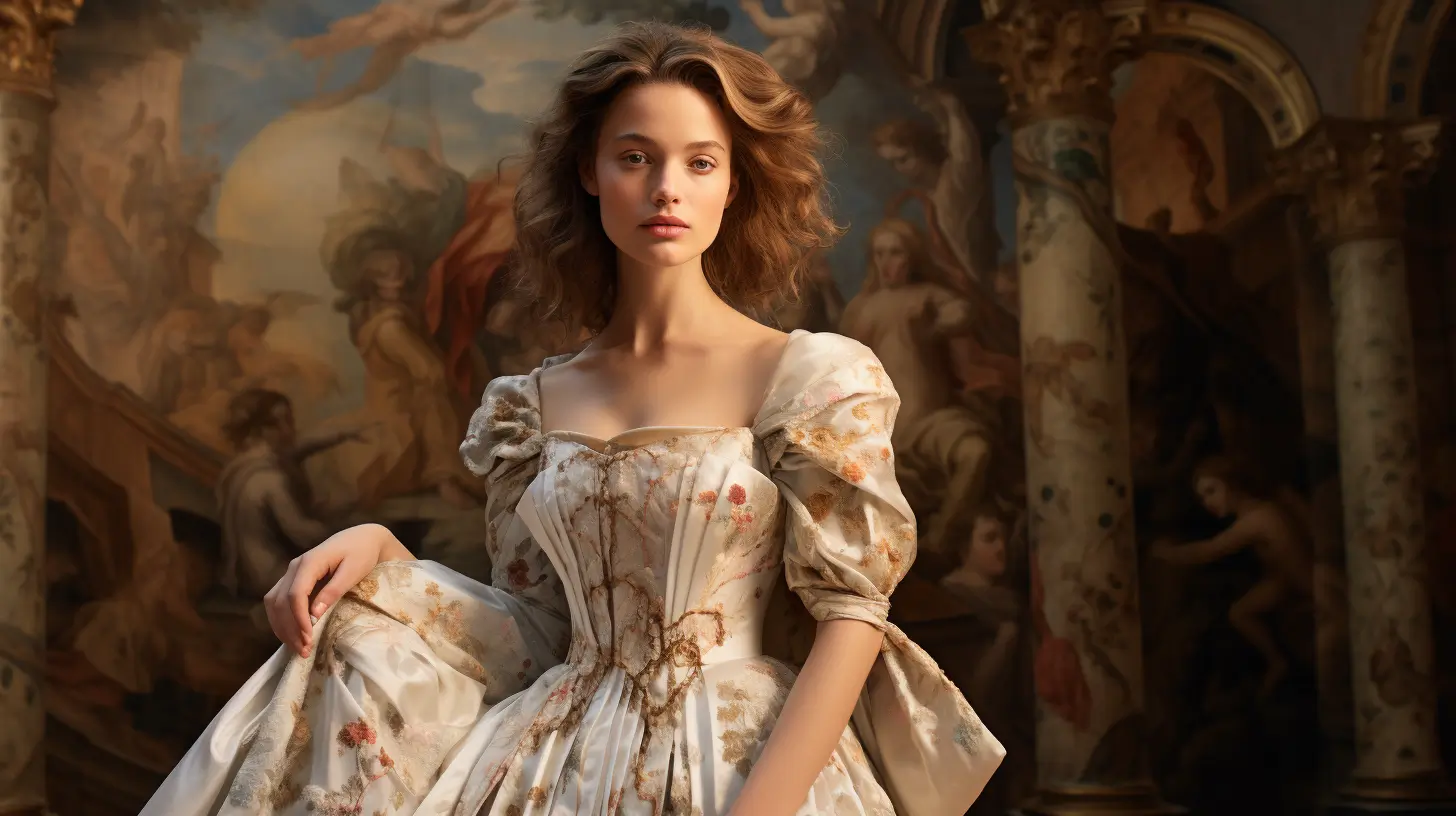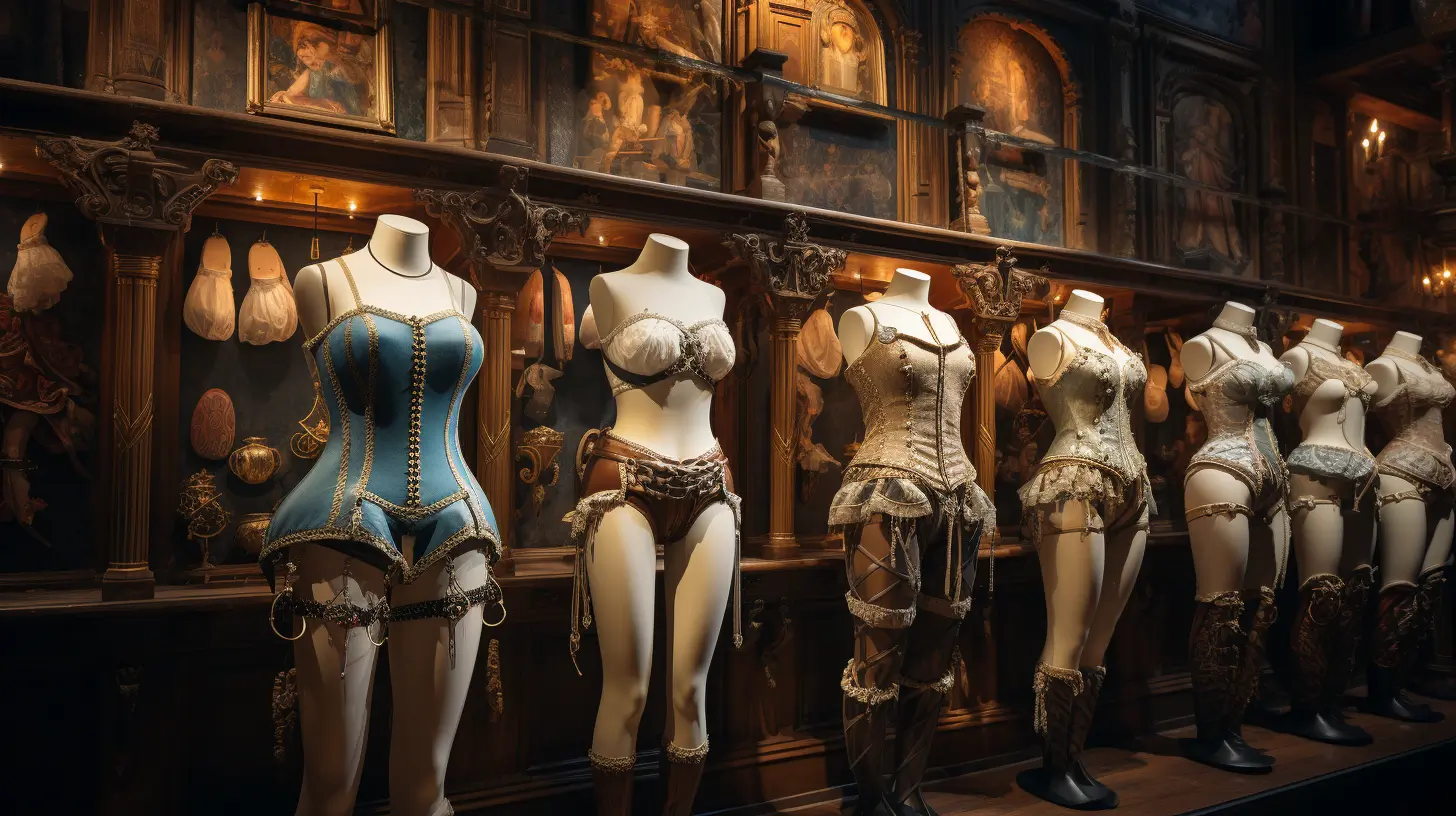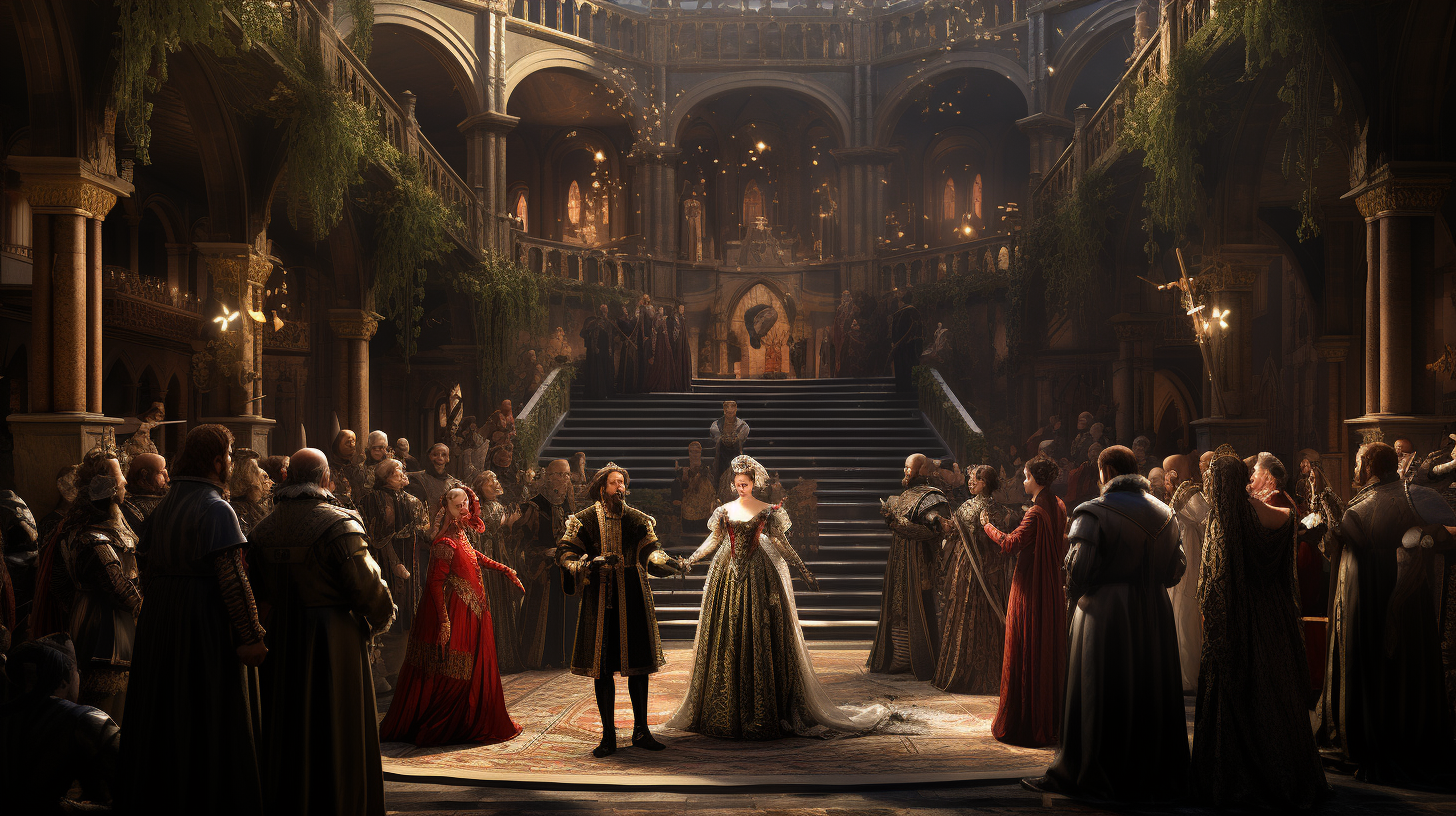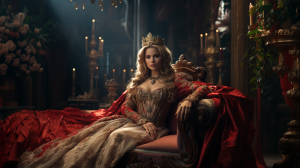
Timeless Elegance Unveiled: A Journey Through Medieval Fashion’s Rich Tapestry
Medieval Mystique: Unveiling the Enigmatic Era 🏰👑
Picture this: You’re standing in the heart of a medieval castle, surrounded by towering stone walls and the echoes of centuries past. The air is filled with an aura of mystery and romance, and you can’t help but be captivated by the allure of the medieval era. Now, let’s embark on a journey to explore the fashion of this enigmatic period.
Overview of Medieval Times: A Glimpse into the Past 🕰🏰
Our next stop on this fashion time travel adventure takes us to the Medieval Times, spanning from the 5th to the late 15th century. It was an era of knights in shining armor, epic quests, and grand castles that seemed to touch the sky.
In this section, we’re diving headfirst into the intricate tapestry of medieval fashion. But before we delve into the details, let’s set the stage and understand the broader context of this fascinating period.
Significance in Fashion History: Why Medieval Fashion Matters 👗👑
Medieval fashion holds a special place in the annals of style evolution. It’s not just about what people wore; it’s about the stories these garments tell. The clothing of this era wasn’t merely a matter of practicality; it was a reflection of social status, religious beliefs, and cultural values.
Intriguingly, medieval fashion wasn’t limited to the elite; it also had a significant impact on the common folk. From peasants to nobles, everyone had their unique attire that spoke volumes about their place in society.
As we unravel the layers of medieval fashion in the following sections, keep in mind that it’s more than just fabric and adornments—it’s a window into a bygone world.
Imagine a vivid medieval scene with a castle looming in the background, its stone walls standing tall against the sky. In the foreground, a diverse array of medieval clothing is displayed, showcasing the rich tapestry of styles from this era. There are knights in armor, nobles in ornate garments, and peasants in simple yet functional attire. The image exudes the aura of the medieval times, transporting viewers to a world of chivalry and intrigue.
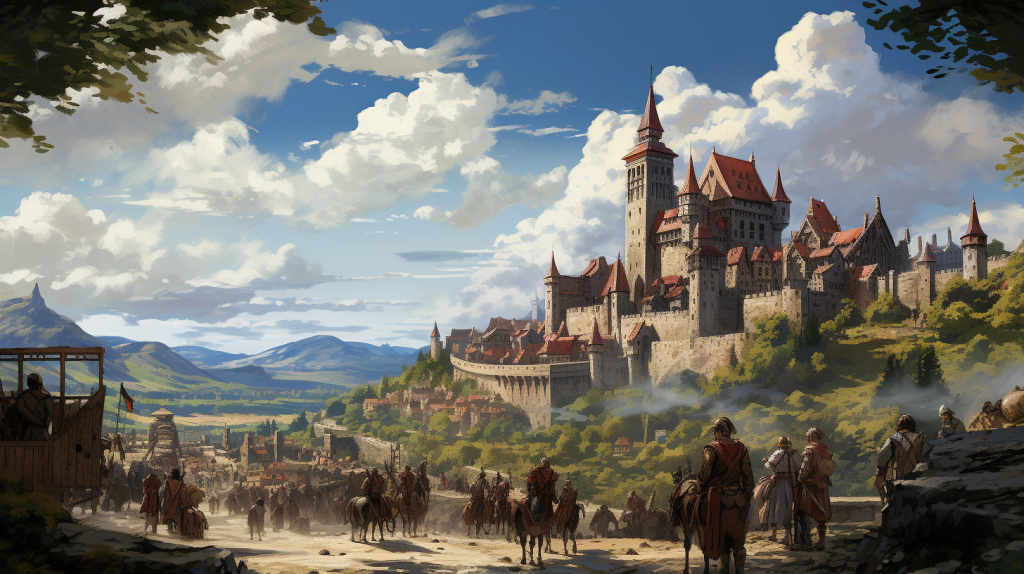
The Thread that Binds: Unraveling Medieval Fabrics 🧵🏰
We’re diving deep into the fabric of medieval society – quite literally. Just as a knight’s armor was his protection, and a queen’s gown her regal attire, the materials and textiles of the time played a crucial role in shaping the fashion landscape.
Common Materials: Wool, Linen, Silk, and Their Uses 🐏🌿🐛
Medieval fashion wasn’t about haute couture runways or the latest designer labels; it was about practicality, tradition, and the available resources. Common materials like wool, linen, and silk took center stage in the wardrobe of medieval men and women.
- Wool, sturdy and warm, was the go-to choice for outerwear, keeping knights and peasants alike snug in the cold winters of the era.
- Linen, lightweight and breathable, was favored for undergarments and everyday wear, ensuring comfort in the summer heat.
- Silk, with its luxurious sheen, was reserved for the elite, adorning the robes of nobility and adding an air of opulence to their ensembles.
Understanding these materials is like deciphering the language of medieval fashion – it tells you who they were and what they valued.
Textile Trade and Economy: How Trade Influenced Fashion 🌍🚢
Medieval fashion wasn’t just about the clothes on one’s back; it was also entwined with global commerce. The intricate network of trade routes brought exotic textiles from distant lands, enriching the tapestry of medieval attire.
The Silk Road, for instance, connected the East and West, allowing for the exchange of silks, spices, and cultural influences. As merchants traversed these routes, they brought back fabrics that would become prized possessions of the medieval elite.
So, when you see a noble draped in sumptuous silks or a knight adorned in fine wool, remember that their attire carries the whispers of distant lands and the stories of countless traders.
Dyeing Techniques and Colors: The Symbolism of Colors 🎨🌈
Medieval fashion wasn’t just about the fabric; it was also about the colors that adorned it. Dyeing techniques were a closely guarded secret, and each hue carried profound symbolism.
- Crimson red symbolized power and wealth, often reserved for royalty and the church.
- Deep blue represented piety and loyalty, worn by knights and those faithful to their lords.
- Earthy greens and browns reflected a connection to nature, embraced by peasants and hunters.
The choice of color was a statement of identity and belief, and deciphering these hues adds layers of meaning to medieval fashion.
Imagine a vivid tapestry of medieval textiles and fabrics laid out before you. Woolen cloaks, linen tunics, and silk gowns are displayed, each showcasing the distinctive qualities of its material. Alongside, there’s a depiction of bustling medieval marketplaces, where traders exchange bolts of colorful fabrics, emphasizing the role of trade in shaping fashion.

As we delve into the materials, trade, and colors of medieval fashion, you’ll gain a deeper appreciation for how these elements wove the fabric of society during this enchanting era. 🧵🏰🌈
Fashion Hierarchy: Dressing the Medieval Social Ladder 👑👢
In this section, we’re taking a deep dive into the social fabric of medieval society, quite literally. Clothing in the Middle Ages wasn’t just about fashion; it was a clear indicator of one’s place in the hierarchy.
Peasant Clothing: Simple, Functional Attire 🌾👒
Picture the hardworking peasants of medieval villages, toiling in the fields and tending to their humble abodes. Their clothing was a testament to practicality and necessity.
Peasant attire was marked by simplicity and durability. Men and women wore tunics made of coarse wool or linen, designed to withstand the rigors of labor. Practicality was the name of the game, with sturdy shoes and head coverings protecting them from the elements.
The colors were often muted, reflecting the natural hues of the materials used. While peasants may not have had the luxury of extravagant fashion, their clothing was a reflection of their resilience and the backbone of medieval society.
Nobility and Royalty: Extravagance and Fashion Statements 👑👗
On the other end of the spectrum were the nobles and royalty, living in castles and courts adorned with opulence. Their clothing was a language of extravagance and power.
Noble attire was a symphony of sumptuous fabrics and intricate details. Rich silks, velvets, and brocades in vibrant colors adorned their garments. Elaborate embroidery and jeweled accents turned clothing into works of art.
Fashion wasn’t just about staying warm or modest for the nobility; it was a statement of their station in life. Gowns with flowing trains, fur-lined cloaks, and crowns encrusted with gems were all part of their regal wardrobe. They didn’t just wear fashion; they embodied it.
Sumptuary Laws: Regulation of Fashion Based on Social Class 📜📏
But in the medieval world, fashion wasn’t entirely a matter of personal choice. Sumptuary laws dictated what one could wear based on their social class. These laws aimed to maintain social order and prevent ostentatious displays of wealth.
For example, sumptuary laws might decree that only nobility could wear certain colors or fabrics, while peasants were restricted to simpler attire. Violating these laws could result in fines or even loss of property.
These laws were a reflection of the tightly knit fabric of medieval society, where what you wore spoke volumes about your place in the world.
Visualize a tapestry-like image showcasing the stark contrast between peasant and noble attire. On one side, humble peasants toil in the fields, wearing simple tunics and practical head coverings. On the other side, the opulent courts of medieval royalty come to life, with regal gowns, jeweled crowns, and sumptuous fabrics that shimmer with extravagance. In the middle, the presence of a parchment with sumptuary laws reminds viewers of the regulation of fashion based on social class.
As we explore the clothing of peasants and nobility, as well as the intriguing world of sumptuary laws, you’ll gain a deeper understanding of how clothing conveyed power, status, and social order in medieval times. 👢👗📜
Dressing the Part: Unveiling Medieval Silhouettes 👚👑
In this section, we’re taking a closer look at the silhouettes that defined the medieval era. Clothing wasn’t just about fabric and materials; it was about the shapes and styles that adorned the people of the time.
Men’s Attire: From Tunics to Hose 👕👖
Let’s begin with the gentlemen of the medieval world. Their attire was characterized by a sense of practicality and function.
- Tunics, typically knee-length and made of wool or linen, were the basic building blocks of a man’s wardrobe. They were versatile enough to be worn daily, and their length denoted social status.
- Hose, a precursor to modern-day trousers, were snug-fitting leg coverings that offered both warmth and mobility.
- Cloaks, often made of wool, served as protection against the elements and added an air of mystery to the wearer.
The silhouette for men was relatively straightforward, emphasizing functionality over extravagance.
Women’s Attire: Gowns, Headdresses, and Their Evolution 👗👒
Moving to the ladies of the medieval court, their attire was a canvas for artistic expression and social standing.
- Gowns were the centerpiece of a noblewoman’s wardrobe. These voluminous dresses, often with tight bodices and flowing skirts, conveyed grace and elegance.
- Elaborate headdresses were a hallmark of medieval women’s fashion. They ranged from intricate veils to towering hennins, each reflecting the wearer’s status and style.
- Layers of undergarments, including chemises and corsets, were essential to achieving the desired silhouette.
As the centuries passed, women’s fashion evolved, with changes in sleeve styles, hemlines, and the introduction of the farthingale—a hoop skirt that created a distinctive bell-shaped silhouette.
Children’s Clothing: How Children Were Dressed 👦👧
Even the youngest members of medieval society had their unique attire, reflecting both practicality and societal norms.
- Infants were swaddled tightly in cloth to ensure their limbs grew straight.
- As children grew older, they transitioned to garments similar to adult clothing, albeit in smaller sizes.
- Boys and girls had distinct clothing, with boys often donning tunics and hose, while girls wore gowns.
Understanding the attire of medieval children gives us insight into the expectations and roles assigned to them from an early age.
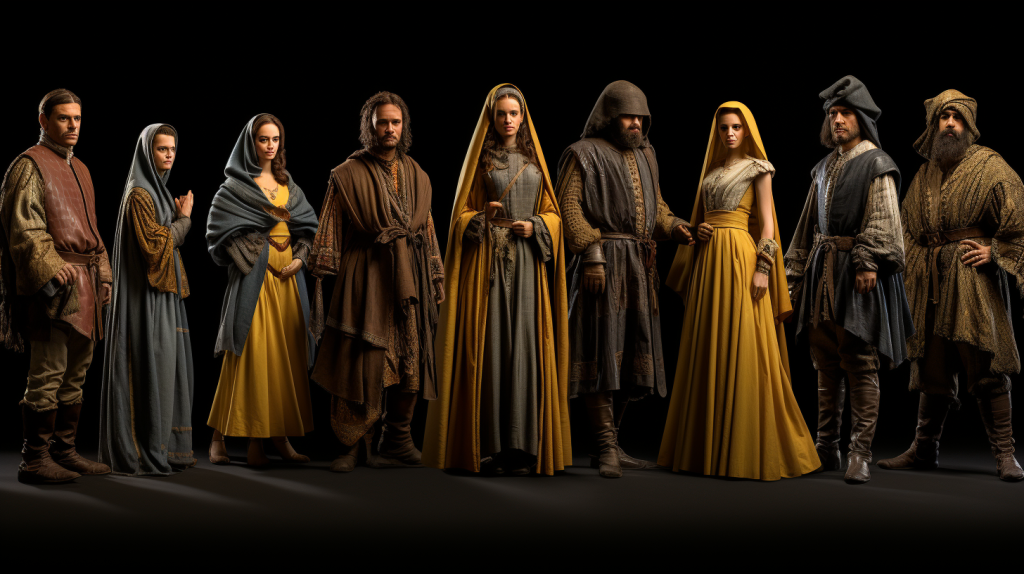
As we explore the attire of men, women, and children, you’ll gain a deeper appreciation for how clothing shaped not only the individual but also the societal roles and norms of the medieval age. 👚👑👖
Accessorizing the Medieval Wardrobe: Form and Function 💍👢
We’re venturing beyond the garments and diving into the world of accessories and footwear. These often-overlooked elements played a pivotal role in defining both the practicality and style of medieval fashion.
Jewelry and Embellishments: Use of Precious Metals and Stones 💎💫
Let’s start with the shimmering world of medieval bling. Jewelry wasn’t just about looking good; it was a symbol of wealth, status, and sometimes even protection.
- Precious metals like gold and silver were crafted into intricate rings, necklaces, and brooches, adorning the nobility from head to toe.
- Gemstones, whether for religious relics or personal adornment, added color and significance to medieval jewelry.
- Embroidery and embellishments on clothing weren’t limited to practicality; they were statements of style. Intricate patterns and metallic threads turned garments into works of art.
These accessories weren’t merely ornamental; they were expressions of the wearer’s identity and societal position.
Footwear: Styles and Social Significance 👞👠
Now, let’s take a walk in their shoes—literally. Medieval footwear was a balance between form and function.
- For peasants and laborers, practicality was key, with sturdy leather boots and shoes designed to withstand long hours of work.
- Nobility, on the other hand, didn’t compromise on style. Pointed, ankle-high shoes with exaggerated toes called “poulaines” became a fashion statement, despite their impracticality.
- The height of one’s shoes often symbolized social status, with the nobility wearing towering platforms to elevate themselves above the masses.
Footwear wasn’t just about keeping feet dry; it was a reflection of the wearer’s aspirations and identity.
Belts, Purses, and Gloves: Practical and Fashionable Uses 🧤👜
Completing the ensemble, belts, purses, and gloves were more than mere accessories—they were indispensable tools of medieval life.
- Belts not only held garments in place but also showcased the wearer’s wealth through elaborate buckles and fittings.
- Purses, often worn as a visible accessory, held essential items and were a statement of one’s status.
- Gloves served both functional and fashionable purposes, protecting hands from the elements while adding a touch of elegance.
Even these seemingly mundane items were steeped in medieval symbolism and style.
Imagine a collage of medieval accessories coming to life. Jewelry made of gleaming precious metals and adorned with radiant gemstones takes center stage, reflecting the opulence of the era. A variety of footwear styles, from sturdy leather boots to extravagant poulaines, showcase the diversity of medieval shoe fashion. Belts with ornate buckles, purses with intricate designs, and gloves of all colors and materials complete the ensemble. The image captures the essence of accessorizing in medieval times, where each item tells a story of function and fashion.
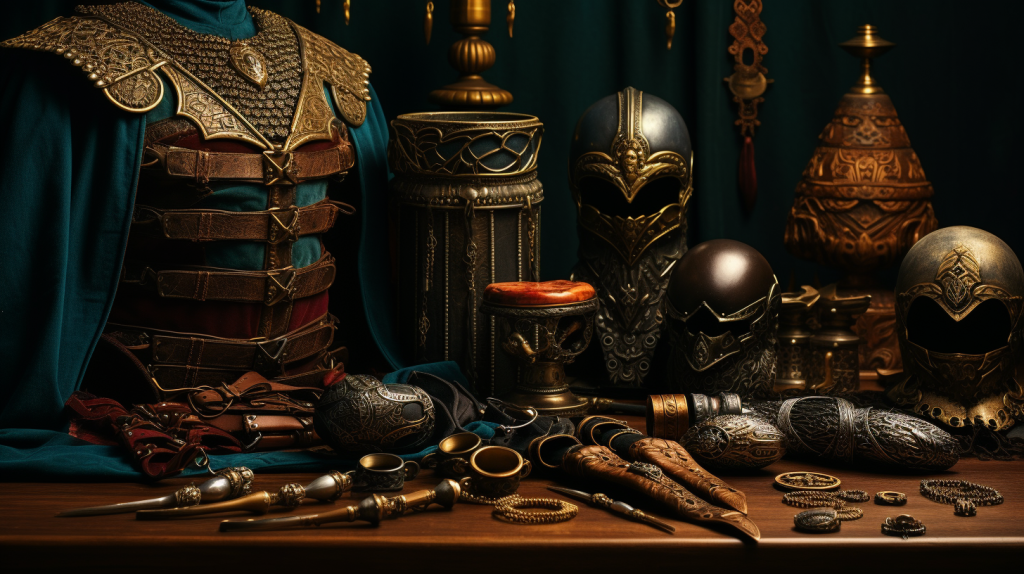
As we delve into the world of accessories and footwear, you’ll discover how even the smallest details of medieval fashion were laden with meaning and style. 💎🧤👠
Threads of Intrigue: Unraveling Medieval Embroidery 🧵✨
In this section, we’re delving deep into the world of embroidery and embellishments, where every stitch and motif tells a story of artistry, symbolism, and social standing.
Embroidery Techniques: Styles and Patterns 🎨🧵
Embroidery in the medieval era was more than just a craft; it was an art form. Various techniques and patterns adorned the clothing of men and women alike.
- Crewelwork: A popular technique using wool threads to create intricate and colorful designs.
- Goldwork: Incorporating gold and silver threads, it added opulence to garments.
- Cross-stitch: Known for its geometric patterns and precise stitches.
- Opus Anglicanum: Renowned for its fine details and exquisite craftsmanship.
From elegant floral motifs to intricate tapestries, embroidery was a way to elevate clothing to a canvas of art.
Religious and Secular Motifs: Symbolism in Designs 🙏🏰
Medieval embroidery wasn’t just about aesthetics; it was a language of symbolism. Designs often carried both religious and secular significance.
- Religious Motifs: Crosses, saints, and biblical scenes adorned the garments of the devout, displaying their piety.
- Secular Motifs: Knights displayed coats of arms, while nobles showcased scenes from chivalric tales. These motifs spoke of one’s lineage and allegiances.
Embroidery was a way to wear one’s faith, values, and allegiances for all to see.
Use of Gold and Silver Threads: Indications of Wealth 💰💫
Gold and silver threads weren’t just for jewelry; they were also woven into the fabric of medieval fashion.
- Goldwork: Reserved for the elite, it added a shimmering, regal touch to clothing.
- Silverwork: Less extravagant than gold but still a sign of affluence.
These precious metal threads weren’t merely decorative; they were indicators of wealth and social standing.
As we explore the world of embroidery and embellishments, you’ll gain a profound appreciation for the craftsmanship and storytelling woven into every stitch of medieval fashion. 🎨🙏💰
My apologies if the previous response did not capture the specific voice you were looking for. Let me revise the section to better align with the requested tone.
European Regions: The Patchwork of Medieval Styles 🗺️👑
Now, we’re voyaging into the heart of medieval fashion, where every corner of Europe had its distinct style and flair.
- England: Picture a land of rugged terrain and practicality. English attire favored functionality over frills. Woolen garments and sturdy leather shoes were the order of the day.
- Italy: Ah, Italy, where artistry and opulence walked hand in hand. Luxurious fabrics like silk and brocade adorned the fashion-forward. Every stitch was a brushstroke on a canvas of style.
- France: The epicenter of haute couture. French fashion set the trends for the continent. Elaborate gowns, pointed shoes, and extravagant headwear were de rigueur.
- Spain: Down in Spain, the Moors left their mark. Vibrant colors, intricate patterns, and exotic influences danced through the streets. Moorish art inspired clothing that was both practical and aesthetically pleasing.
These regional nuances weren’t just about dressing for the weather; they were about expressing cultural identity.
Influence of the Crusades: A Taste of the East 🏰🌄
The Crusades weren’t just about military conquest; they were grand expeditions of cultural exchange. Eastern influences began to trickle into medieval Europe, leaving an indelible mark on fashion.
- Silk and Brocades: From the exotic East came sumptuous silk and intricate brocades, transforming European attire into a tapestry of luxury.
- Moorish Inspirations: Imagine geometric patterns and vibrant colors borrowed from Moorish art. These influences infused a sense of the exotic into European clothing.
- Jewelry and Accessories: Eastern motifs and precious gemstones found their way into the jewelry boxes of European nobility.
The Crusades brought not only relics but also a taste for the exotic, reshaping European fashion forever.
The Church and Fashion: Where Faith Meets Fabric 🙏👗
The Church held sway over medieval society, and its influence reached into every wardrobe.
- Religious Vestments: Clergy donned elaborate robes, each stitch a testament to their spiritual calling.
- Modesty and Piety: The Church championed modesty, resulting in clothing that covered more and shone less.
- Religious Symbols: Crosses, saints’ relics, and other sacred symbols graced garments, signaling devotion and faith.
Fashion became a canvas for expressing religious devotion and adherence to moral codes.
Picture a captivating collage that brings these diverse fashion influences to life. English practicality rubs shoulders with Italian opulence, while French haute couture takes center stage next to Spain’s vibrant Moorish-inspired creations. The Crusades act as a bridge, with silks, brocades, and intricate patterns flowing from the East into European fashion. In the midst of it all, the Church’s influence is evident through the clergy’s regal vestments and the modest clothing of the faithful.
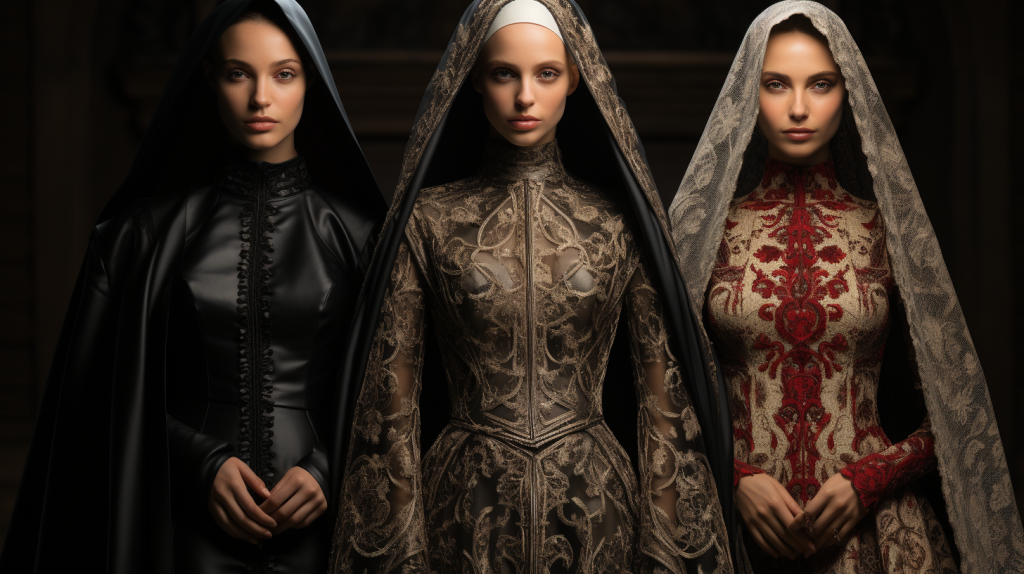
As we explore the impact of culture, geography, and religion on medieval fashion, you’ll gain a deeper understanding of how clothing was a reflection of the rich tapestry of medieval society. 🗺️🙏👗
Armor and Battle Attire: Where Style Meets Steel ⚔️🛡️
We’re venturing into a realm where fashion served a dual purpose: protecting the wearer in battle and making a striking statement.
Knights and Nobles: The Evolution of Armor 🪶👑
When we think of medieval armor, images of knights in shining armor often come to mind. But armor was far from static; it evolved over centuries.
- Chainmail: An early form of armor, made of interlocking rings, offering flexibility and protection.
- Plate Armor: Iconic full suits of armor made of metal plates, providing near-impervious protection.
- Jousting Armor: Specialized armor designed for tournaments and jousting, where both protection and visibility were crucial.
Armor wasn’t just a matter of defense; it was a symbol of chivalry and status. Knights adorned their armor with intricate designs and heraldic symbols to stand out on the battlefield.
Women’s Armor and Riding Attire: A Rare but Significant Aspect 🐎👸
While often overshadowed by male knights, women also had their unique place in medieval armor and riding attire.
- Heraldic Surcoats: Women of nobility donned surcoats, displaying family coat of arms.
- Padded Armor: Underneath their elegant garments, noblewomen sometimes wore padded armor for protection during travel or even combat.
- Riding Habits: Tailored for equestrian activities, riding attire for women was designed for both functionality and style.
Though less common, women’s armor and riding attire were essential for those who participated in the martial aspects of medieval life.
Symbolism and Heraldry: Personal and Family Identities 🏰🛡️
Heraldry was more than just decoration on armor; it was a language of symbols and colors.
- Coat of Arms: These designs represented families, regions, or individual knights. They were emblazoned on shields, surcoats, and banners.
- Colors and Symbols: Each element of heraldry carried meaning, from the choice of colors to the animals and objects depicted.
Heraldry was a way for knights to communicate their identity, allegiances, and achievements on the battlefield.
Visualize a vivid montage that brings the world of medieval armor and battle attire to life. Women Knights clad in chainmail, plate armor, and jousting gear stand tall, their armor adorned with intricate heraldic symbols and personalized designs. Noblewomen in their heraldic surcoats and padded armor add a touch of elegance to the martial scene. In the background, the colors and symbols of heraldry form a vibrant tapestry of personal and family identities, each element carefully crafted to convey meaning and honor.
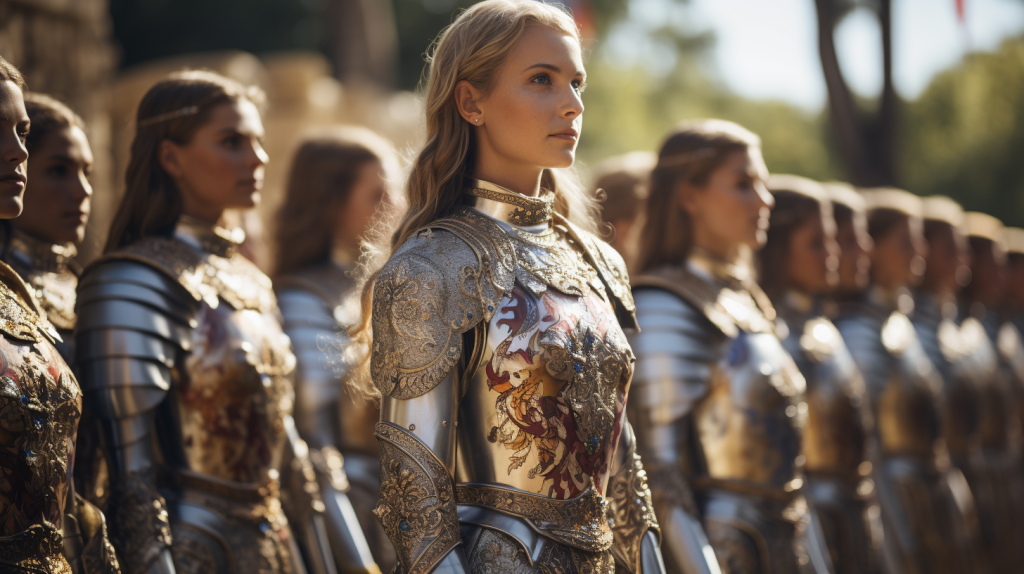
As we explore the functionality and symbolism of medieval armor and battle attire, you’ll gain a deeper appreciation for how fashion was not only a matter of personal style but also a reflection of honor, identity, and the rigors of the battlefield. 🪶🏰🐎
Medieval Fashion in Pop Culture: Cinematic and Literary Reverberations 🎬📚
In this section, we’re diving deep into the silver screen and the pages of literature to explore how medieval fashion continues to captivate audiences through its presence in movies, TV shows, and literature.
Epic Films: Timeless Costumes on the Big Screen 🍿🎞️
Picture yourself in a darkened theater, the silver screen illuminated by the grandeur of medieval costumes.
- “Braveheart”: William Wallace’s kilted rebellion, set against a backdrop of rugged Scottish landscapes, showcased both practicality and symbolism.
- “Gladiator”: Maximus Decimus Meridius donned armor that exuded strength and valor, while Commodus’s elaborate attire revealed his decadence.
- “Lord of the Rings”: From the elegance of elven robes to the ruggedness of hobbit attire, this epic saga breathed life into J.R.R. Tolkien’s vision.
These films transport viewers to medieval realms, where costumes become characters in their own right.
TV Series: Medieval-Inspired Wardrobes on the Small Screen 📺🏰
Television series have not shied away from embracing medieval fashion.
- “Game of Thrones”: Westeros came alive with intricately designed attire that reflected the diverse cultures within the series, from the stark minimalism of the North to the opulence of King’s Landing.
- “The Witcher”: Geralt’s armor and Yennefer’s robes captured the gritty yet fantastical essence of Andrzej Sapkowski’s novels.
- “Merlin”: This retelling of Arthurian legends showcased medieval-inspired costumes that transported viewers to the magical world of Camelot.
TV shows allow us to explore the complexities of medieval fashion across multiple episodes, adding depth to the narrative.
Literary Adventures: Page-Turning Medieval Worlds 📚🏞️
Medieval-themed novels and fantasy literature invite readers to traverse time and space through their descriptions of clothing and settings.
- “Pillars of the Earth”: Ken Follett’s novel paints a vivid picture of medieval life, including the construction of cathedrals and the attire of the era.
- “A Song of Ice and Fire”: George R.R. Martin’s series served as the foundation for “Game of Thrones,” immersing readers in the richly described clothing and customs of Westeros.
- “The Once and Future King”: T.H. White’s Arthurian tale provides a literary journey through medieval attire and chivalry.
These novels transport us to meticulously crafted medieval worlds where fashion is an integral part of the narrative.
Imagine a captivating collage that brings together iconic scenes from medieval-inspired movies and TV shows. Braveheart’s William Wallace stands tall in his kilt, while Maximus from Gladiator embodies valor in his armor.
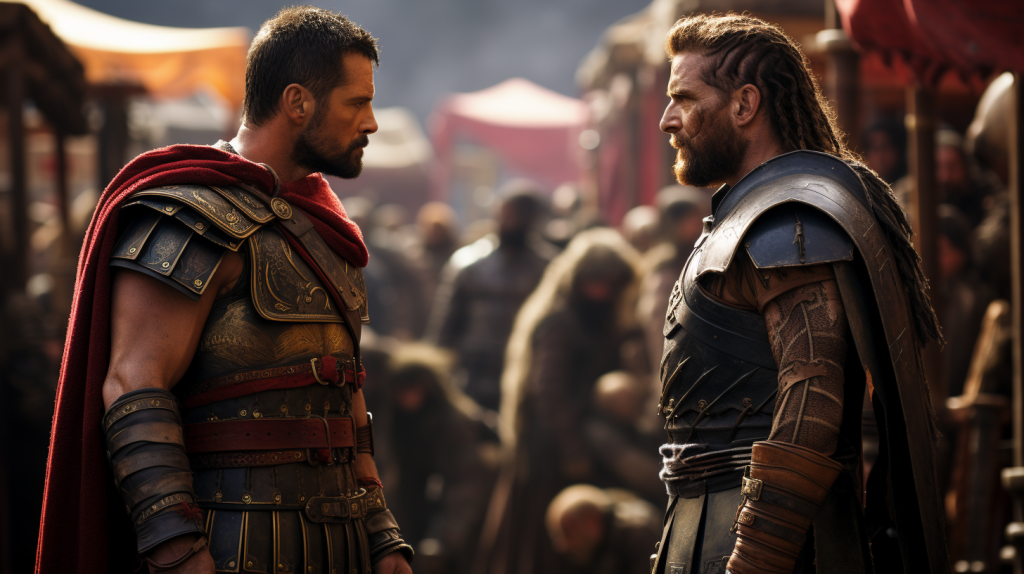
As we delve into the impact of medieval fashion in pop culture, you’ll see how these cinematic and literary representations continue to keep the legacy of medieval style alive in our modern imagination. 🍿📺📚
Conclusion: Unraveling the Threads of Time 🕰️👑
As we wrap up our journey through the annals of medieval fashion, it’s time to reflect on the importance of this rich and timeless tapestry.
Recap of Medieval Fashion’s Importance: Summarize Key Points 📜👗
Medieval fashion isn’t just a collection of garments from bygone eras; it’s a window into the past, a testament to human creativity and ingenuity. We’ve delved into the fabrics that shaped societies, the class distinctions reflected in clothing, the key designs and outfits that defined eras, and the artistry of embroidery and embellishments. We’ve explored the cultural and geographic influences that left their mark on medieval attire and the functional elegance of armor and battle attire.
Enduring Influence: Why Medieval Fashion Still Matters Today 💫🏰
The legacy of medieval fashion endures in contemporary design, Renaissance fairs, modern fashion, and pop culture. Its timeless allure transcends time and space, connecting us to the craftsmanship, symbolism, and artistic expression of centuries past. Just as medieval fashion evolved to reflect the values and ideals of its time, it continues to inspire creativity and exploration in the present day.
Invitation for Engagement: Encourage Readers to Explore Medieval Fashion 🏴🪙
I invite you, dear readers, to continue this fascinating journey beyond these pages. Dive into the world of medieval fashion, whether through crafting your own attire, participating in historical reenactments, or simply delving deeper into the rich history. Connect with fellow enthusiasts, share your discoveries, and let the spirit of medieval fashion enrich your understanding of the past and present.
And as I conclude, remember that my love for medieval fashion is as deep as my appreciation for all the wonders of the world. I wish you love, light, and may God save the queen.
Picture a grand medieval tapestry, carefully woven over centuries. It depicts a journey through time, from the simplicity of peasant clothing to the opulence of royalty, from the battlefields of knights to the elegant gowns of ladies. This tapestry is a visual representation of the importance and enduring influence of medieval fashion. It weaves together the threads of history, culture, and creativity, inviting us to step into a world where clothing tells stories and traditions transcend time.
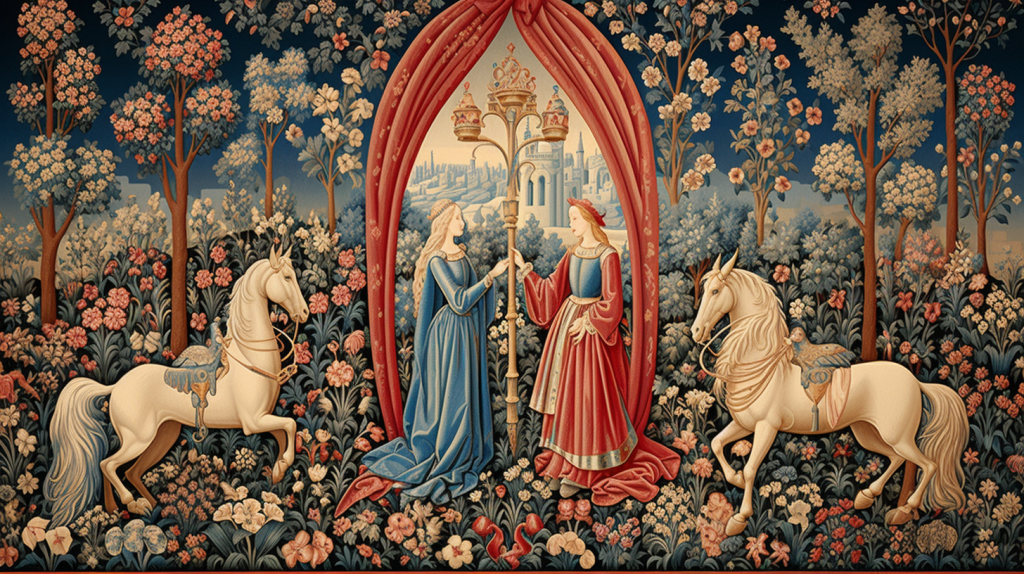
As our exploration of medieval fashion concludes, may you carry the essence of this journey with you, appreciating the beauty, significance, and lasting impact of the garments that once graced the halls of castles and the streets of medieval towns.


